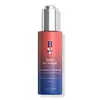What's inside
What's inside
 Key Ingredients
Key Ingredients

 Benefits
Benefits

 Concerns
Concerns

 Ingredients Side-by-side
Ingredients Side-by-side

Water
Skin ConditioningButylene Glycol
HumectantPPG-26-Buteth-26
Skin ConditioningPEG-40 Hydrogenated Castor Oil
EmulsifyingApigenin
AntioxidantOleanolic Acid
Skin ConditioningBiotinoyl Tripeptide-1
Quercus Serrata Extract
Skin ConditioningRosmarinus Officinalis Extract
AntimicrobialHydroxyethylcellulose
Emulsion StabilisingSophora Japonica Extract
EmollientNiacinamide
SmoothingAscorbic Acid
AntioxidantBisabolol
MaskingBiotin
AntiseborrhoeicHydrolyzed Rice Protein
Skin ConditioningTocopheryl Acetate
AntioxidantSodium PCA
HumectantPolysorbate 20
EmulsifyingCitrus Aurantium Dulcis Oil
MaskingVinegar
Dicalcium Phosphate
AbrasiveXanthan Gum
EmulsifyingPhenoxyethanol
PreservativeEthylhexylglycerin
Skin ConditioningLimonene
PerfumingWater, Butylene Glycol, PPG-26-Buteth-26, PEG-40 Hydrogenated Castor Oil, Apigenin, Oleanolic Acid, Biotinoyl Tripeptide-1, Quercus Serrata Extract, Rosmarinus Officinalis Extract, Hydroxyethylcellulose, Sophora Japonica Extract, Niacinamide, Ascorbic Acid, Bisabolol, Biotin, Hydrolyzed Rice Protein, Tocopheryl Acetate, Sodium PCA, Polysorbate 20, Citrus Aurantium Dulcis Oil, Vinegar, Dicalcium Phosphate, Xanthan Gum, Phenoxyethanol, Ethylhexylglycerin, Limonene
Water
Skin ConditioningPolysorbate 20
EmulsifyingButylene Glycol
HumectantGlycerin
HumectantPolyquaternium-7
Rhodiola Rosea Extract
EmollientSodium Hyaluronate
HumectantTocopheryl Acetate
AntioxidantAcetyl Tetrapeptide-3
Skin ProtectingTocopherol
AntioxidantRosa Centifolia Flower Extract
AstringentDextran
Trifolium Pratense Flower Extract
AstringentAcanthopanax Senticosus Root Extract
Skin ConditioningRhaponticum Carthamoides Root Extract
Skin ConditioningInonotus Obliquus Extract
Skin ConditioningSelaginella Lepidophylla Extract
EmollientEthylhexylglycerin
Skin ConditioningDisodium EDTA
Sodium Hydroxide
BufferingAcrylates/C10-30 Alkyl Acrylate Crosspolymer
Emulsion StabilisingCitric Acid
BufferingSodium Benzoate
MaskingPhenoxyethanol
PreservativeParfum
MaskingEugenol
PerfumingLimonene
PerfumingLinalool
PerfumingWater, Polysorbate 20, Butylene Glycol, Glycerin, Polyquaternium-7, Rhodiola Rosea Extract, Sodium Hyaluronate, Tocopheryl Acetate, Acetyl Tetrapeptide-3, Tocopherol, Rosa Centifolia Flower Extract, Dextran, Trifolium Pratense Flower Extract, Acanthopanax Senticosus Root Extract, Rhaponticum Carthamoides Root Extract, Inonotus Obliquus Extract, Selaginella Lepidophylla Extract, Ethylhexylglycerin, Disodium EDTA, Sodium Hydroxide, Acrylates/C10-30 Alkyl Acrylate Crosspolymer, Citric Acid, Sodium Benzoate, Phenoxyethanol, Parfum, Eugenol, Limonene, Linalool
Ingredients Explained
These ingredients are found in both products.
Ingredients higher up in an ingredient list are typically present in a larger amount.
Butylene Glycol (or BG) is used within cosmetic products for a few different reasons:
Overall, Butylene Glycol is a safe and well-rounded ingredient that works well with other ingredients.
Though this ingredient works well with most skin types, some people with sensitive skin may experience a reaction such as allergic rashes, closed comedones, or itchiness.
Learn more about Butylene GlycolEthylhexylglycerin (we can't pronounce this either) is commonly used as a preservative and skin softener. It is derived from glyceryl.
You might see Ethylhexylglycerin often paired with other preservatives such as phenoxyethanol. Ethylhexylglycerin has been found to increase the effectiveness of these other preservatives.
Limonene is a fragrance that adds scent and taste to a formulation.
It's found in the peel oil of citrus fruits and other plants such as lavender and eucalyptus. The scent of limonene is generally described as "sweet citrus".
Limonene acts as an antioxidant, meaning it helps neutralize free radicals.
When exposed to air, oxidized limonene may sensitize the skin. Because of this, limonene is often avoided by people with sensitive skin.
The term 'fragrance' is not regulated in many countries. In many cases, it is up to the brand to define this term. For instance, many brands choose to label themselves as "fragrance-free" because they are not using synthetic fragrances. However, their products may still contain ingredients such as essential oils that are considered a fragrance.
Learn more about LimonenePhenoxyethanol is a preservative that has germicide, antimicrobial, and aromatic properties. Studies show that phenoxyethanol can prevent microbial growth. By itself, it has a scent that is similar to that of a rose.
It's often used in formulations along with Caprylyl Glycol to preserve the shelf life of products.
Polysorbate 20 is made by combining ethoxylation of sorbitan, ethylene oxide, and lauric acid. It is a mild cleansing agent, surfactant, and emulsifier.
As a surfactant, it helps collect dirt and oils for washing. Emulsifiers prevent oils and water from separating.
Polysorbate 20 also adds scent to a product. Since it is made using sorbitol, it has a sweet scent. Sorbitol can also be found in fruits such as apples and peaches.
The lauric acid used to create Polysorbate 20 is often derived from coconuts.
Polysorbate 20 may not be fungal acne safe.
Learn more about Polysorbate 20Tocopheryl Acetate is AKA Vitamin E. It is an antioxidant and protects your skin from free radicals. Free radicals damage the skin by breaking down collagen.
One study found using Tocopheryl Acetate with Vitamin C decreased the number of sunburned cells.
Tocopheryl Acetate is commonly found in both skincare and dietary supplements.
Learn more about Tocopheryl AcetateWater. It's the most common cosmetic ingredient of all. You'll usually see it at the top of ingredient lists, meaning that it makes up the largest part of the product.
So why is it so popular? Water most often acts as a solvent - this means that it helps dissolve other ingredients into the formulation.
You'll also recognize water as that liquid we all need to stay alive. If you see this, drink a glass of water. Stay hydrated!
Learn more about Water